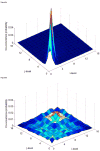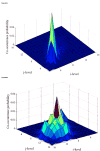Exploring feature-based approaches in PET images for predicting cancer treatment outcomes
- PMID: 20161266
- PMCID: PMC2701316
- DOI: 10.1016/j.patcog.2008.08.011
Exploring feature-based approaches in PET images for predicting cancer treatment outcomes
Abstract
Accumulating evidence suggests that characteristics of pre-treatment FDG-PET could be used as prognostic factors to predict outcomes in different cancer sites. Current risk analyses are limited to visual assessment or direct uptake value measurements. We are investigating intensity-volume histogram metrics and shape and texture features extracted from PET images to predict patient's response to treatment. These approaches were demonstrated using datasets from cervix and head and neck cancers, where AUC of 0.76 and 1.0 were achieved, respectively. The preliminary results suggest that the proposed approaches could potentially provide better tools and discriminant power for utilizing functional imaging in clinical prognosis.
Figures








References
-
- Biersack HJ, Bender H, Palmedo H. FDG-PET in monitoring therapy of breast cancer. Eur J Nucl Med Mol Imaging. 2004;31 1:S112–7. - PubMed
-
- Bradley J, Thorstad WL, Mutic S, et al. Impact of FDG-PET on radiation therapy volume delineation in non-small-cell lung cancer. Int J Radiat Oncol Biol Phys. 2004;59:78–86. - PubMed
-
- Mutic S, Malyapa RS, Grigsby PW, et al. PET-guided IMRT for cervical carcinoma with positive para-aortic lymph nodes-a dose-escalation treatment planning study. Int J Radiat Oncol Biol Phys. 2003;55:28–35. - PubMed
-
- Brun E, Kjellen E, Tennvall J, et al. FDG PET studies during treatment: prediction of therapy outcome in head and neck squamous cell carcinoma. Head Neck. 2002;24:127–35. - PubMed
-
- Hope AJ, Saha P, Grigsby PW. FDG-PET in carcinoma of the uterine cervix with endometrial extension. Cancer. 2006;106:196–200. - PubMed
Grants and funding
LinkOut - more resources
Full Text Sources
Other Literature Sources
